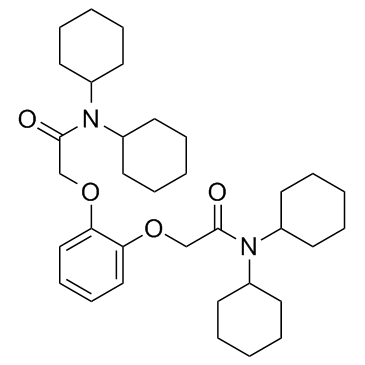Sodium ionophore III (ETH2120) (Synonyms: ETH 2120) |
| Catalog No.GC31279 |
Sodium ionophore III (ETH2120) (ETH2120) is a Na+ ionophore suitable for the assay of sodium activity in blood, plasma, serum.
Products are for research use only. Not for human use. We do not sell to patients.

Cas No.: 81686-22-8
Sample solution is provided at 25 µL, 10mM.
Sodium ionophore III (ETH2120) is a Na+ ionophore.
Cell suspensions of Acetobacterium woodii prepared from cultures grown on fructose plus caffeate catalyzed caffeate reduction with electrons derived from molecular hydrogen. The sodium ionophore Sodium ionophore III (ETH2120), stimulated hydrogen-dependent caffeate reduction by 280%, indicating that caffeate reduction is coupled to the buildup of a membrane potential generated by primary Na(+) extrusion[1]. Rnf is a membrane protein complex, The addition of the protonophore TCS strongly inhibited lactate-sulfate dependent growth whereas the sodium ionophore Sodium ionophore III (ETH2120) had no effect, indicating a role for the proton gradient during growth. [2]. In the considered nitrobenzene medium, the investigated Sodium ionophore III ligand is a very effective receptor for the Eu3+ and Am3+ cations[3].
The addition of the Na+-selective ionophore Sodium ionophore III (ETH2120) or the protonophore CCCP or the H+/cation-antiporter monensin revealed that an H+ gradient is used as primary energy conservation mechanism, which strengthens the exceptional position of C. aceticum as acetogenic bacterium showing an H+-dependent energy conservation mechanism as well as Na+-dependent growth[4].
References:
[1]: Imkamp F, MÜller V. Chemiosmotic energy conservation with Na(+) as the coupling ion during hydrogen-dependent caffeate reduction by Acetobacterium woodii. J Bacteriol. 2002 Apr;184(7):1947-51. doi: 10.1128/JB.184.7.1947-1951.2002. PMID: 11889102; PMCID: PMC134933.
[2]: Wang L, Bradstock P, et,al. The role of Rnf in ion gradient formation in Desulfovibrio alaskensis. PeerJ. 2016 Apr 14;4:e1919. doi: 10.7717/peerj.1919. PMID: 27114876; PMCID: PMC4841214.
[3]: MakrlÍk, E., KvÍ?alovÁ, M. et,al.Sodium Ionophore III as Very Effective Receptor for Trivalent Europium and Americium. J Solution Chem 45, 463-474 (2016). https://doi.org/10.1007/s10953-016-0447-0
[4]: Mayer A, Weuster-Botz D. Reaction engineering analysis of the autotrophic energy metabolism of Clostridium aceticum. FEMS Microbiol Lett. 2017 Dec 1;364(22). doi: 10.1093/femsle/fnx219. PMID: 29069379.
Average Rating: 5 (Based on Reviews and 40 reference(s) in Google Scholar.)
GLPBIO products are for RESEARCH USE ONLY. Please make sure your review or question is research based.
Required fields are marked with *




















